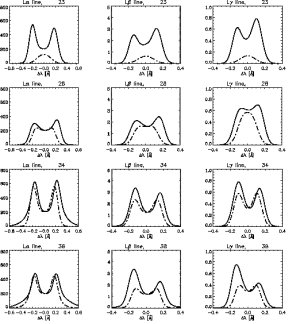|
|  |
Solar prominences are relatively cool structures having around 8000 K
which extend high into the corona which is several million K hot.
They can be observed best in the strong H-alpha line of neutral
hydrogen. They can also be seen in other spectral lines and an
example is shown in our Fig. 1. When seen against the solar disc in
H-alpha they appear as dark structures called filaments which
usually have very detailed fine structure.A typical example is given
in Fig. 2.
With the SUMER (Solar Ultraviolet Measurements of Emitted Radiation)
spectrograph onboard of SOHO (Solar and Heliospheric Observatory) they
have been observed recently in the Lyman lines of hydrogen. The
position of the spectrograph slit is shown by the solid white line in
Fig. 1. Some examples of the profiles taken at several positions
along the slit of the lowest two of these lines are given in
Fig. 3. One surprising result of these new observations was the fact
that in many cases these line profiles are highly non-symmetric.
Theoretical models for prominence fine structures have been developed
by Ulrich Anzer in collaboration with Petr Heinzel and Stanislav
Gunar from the Astronomical Institute in Ondrejov. With these
models we were able to reproduce the observed asymmetries. For this
investigation we used a configuration which consisted of several
individual thread structures which had randomly selected line-of-sight
(LOS) velocities and the threads were also randomly displaced in the
direction perpendicular the LOS. We applied detailed radiative
transfer calculations to these models. From our calculations we found
that rather small LOS velocities in the range between -10 km/s and +10
km/s were sufficient to produce large asymmetries. Some examples can
be seen in Fig. 4. The physical mechanism which produces these results
lies in the fact that the different threads have different relative
velocities. Therefore the emission from one such thread will be
absorbed by the threads in front of it and this absorption is Doppler
shifted with respect to the emitter. This then can lead to a large
asymmetry of the profiles. The interesting point is that already small
velocities can give such asymmetries. The reason for this is that on
the one hand the line profiles are strongly reversed with two narrow
peaks on the two sides, and that on the other hand the absorption
profiles are very steep.
These new results give strong support for the necessity to include
fine structure dynamics in realistic prominence models.
Ulrich Anzer
Publications
Stanislav Gunar, Petr Heinzel, Ulrich Anzer and Brigitte Schmieder,
"On Lyman-line asymmetries in quiescent prominences",
2008, Astronomy & Astrophysics 490, 307 - 313
|





